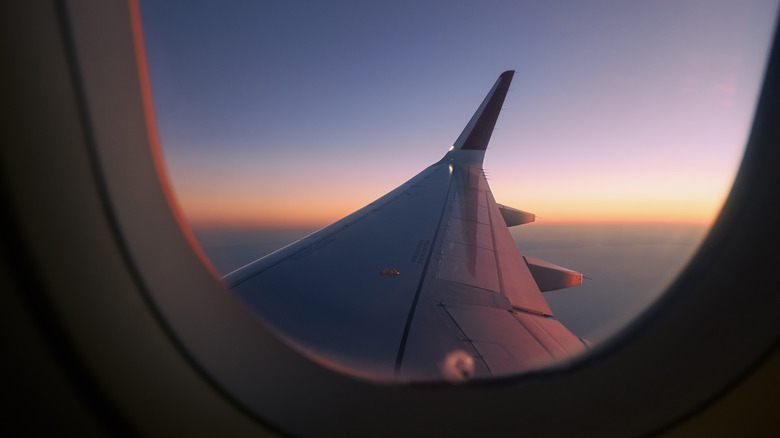How Google & Other Flight-Tracking Apps Know Exactly Where A Plane Is At Any Time
For amateur aviation enthusiasts, there's no greater thrill than watching an airplane steer on the ground and then take to the air. It's quite the feat of physics and engineering to get an aircraft to take off in the first place, even a lightweight and modest one. But what about once it's out of sight, or if we're not watching in person? Today, of course, there's an app for that. Not only are there apps for booking cheap flights, but there are also apps for tracking the flights of our friends and family. You may have wondered just how these apps can track the exact, live position of a plane in the air, especially when you consider that some services display the live position of hundreds of them at once.
Today's aircraft are typically equipped with a suite of features that, in tandem with infrastructure on the ground, allow these services to track them. One of the biggest names in the field of flight-tracking is Flightradar24, which you may have already used. Flightradar24 reports that, in addition to the obvious satellite and radar information that it uses to determine the positions of airplanes, some less familiar sources of information, such as Multilateration (which uses the time taken for a signal traveling from an aircraft to a receiver to determine its position) and Automatic Dependent Surveillance Broadcast, are also used to track a flight's progress. These systems have their individual limitations, but they all contribute to the comprehensive picture of aviation that Google and other flight trackers can provide.
How flight trackers detect such a great number of different types of aircraft
At the time of writing, Flightradar24 was recording the positions of a global total of approximately 16,138 aircraft. There are sure to be a huge variety of different types of aircraft among that number, and the on-board equipment may differ significantly between them. Nonetheless, a large majority of all these aircraft (13,752 of them), according to the service's live statistics, were being tracked by one particular method: ADS-B.
ADS-B stands for Automatic Dependent Surveillance-Broadcast. It has two critical components: ADS-B In, which provides an aircraft's pilot with positioning information and important warnings, and ADS-B Out. The latter provides stations back down on terra firma, as well as fellow aircraft, with similar vital details about that plane's movements (such as GPS data). These stations are positioned around the world, and with this information delivered from the aircraft 60 times a minute, it is incredibly accurate and far-reaching.
The next most commonly used source of aircraft tracking information displayed on Flightradar24 is MLAT (721 global aircraft at the time of writing). This system isn't quite as accurate as ADS-B, but it provides tracking details for those aircraft that lack an ADS-B transponder (it uses a Mode S one instead). With MLAT, or Multilateration, a system known as time difference of arrival is used to detect an aircraft's position relative to multiple detection facilities on the ground. The information from typically four of these stations allows the service to determine the location and path of the aircraft.
The information-gathering process, and some potential flaws
Flight tracking services, then, have access to a global web of information, which helps to pinpoint where an airplane is on its flight path. The various methods of tracking aircraft, however, aren't without their flaws. ADS-B, while broadly available and a critical tool, isn't available for aircraft that lack the appropriate transponder, and global coverage can be limited. FlightAware's FlightFeeder program, in which eligible hosts (or those who buy the FlightFeeder Pro) can use the small device and included antenna to detect and translate those ADS-B signals, is one way of expanding this coverage.
Multilateration has its own shortcomings. The aircraft has to be within range of at least four different receivers, and not obscured from any, so those areas with less coverage cannot rely on this method. A big advantage of MLAT, though, is that it can still be used when other, more conventional methods of tracking, such as GPS, are temporarily unavailable.
ADS-B lets an aircraft transmit its precise location and other information via satellite and GPS. This makes it rather more reliable than range-limited radar. There isn't a perfect system, and making tracking details absolutely precise is very difficult (MLAT can require up to around 6 seconds for updates when data delays are taken into account). As such, the live data you see when using tracking apps like FlightAware can be ever so slightly delayed.


